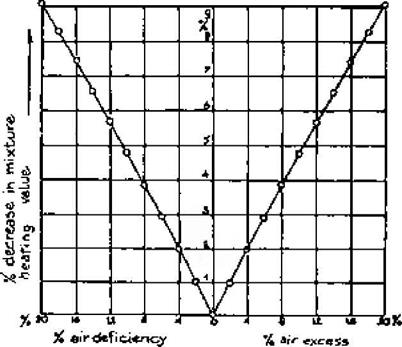 Maximizing the power output in producer-gas operation
Maximizing the power output in producer-gas operation
The possibilities of maximizing the power output are generally related to the theoretical causes of power loss discussed in the preceding section. They will be treated in the same order here.
(a) Heating value of the mixture
It is evident that the highest heating values for the combustible mixture are achieved at the highest heating value of the producer gas itself. As will be explained later, the heating value depends on the design of the gasifier and on the characteristics of the fuel provided to the gasifier. Minimization of the heat losses from the gasifier is important in order to achieve a high heating value of the gas. The moisture content and the size distribution are two of the most important fuel characteristics.
In mixing the producer gas with combustion air there is an additional reason for power loss because of changes in the composition of the gas, as well as of variations in pressure drop over the gasifier installation and it is very difficult to maintain continuously a stoichiometric mixture of producer gas and air.
Because both excess and deficiency of air lead to a decrease in the heating value of the mixture (per unit volume), both will lead to a decrease in power output as illustrated in figure 2.3.
|
Figure 2.3 Decrease of the heating value of a producer gas/air mixture as a function of air deficiency or excess (34)
|
The only feasible way to adjust the mixture to its stoichiometric combustion is by-installing a hand operated valve on the combustion air inlet of the engine and operating this regularly for maximum engine power output.
If maximum engine power output is not needed, it is usually better to operate the engine with a slight excess of air, in order to prevent backfiring in the engine exhaust gas system.
(b) Amount of combustible mixture
Apart from minimizing the pressure drop over the gasifier, cooling and cleaning system and carburettor (while still maintaining adequate gas/air mixing as discussed above) the amount of combustible mixture per engine combustion stroke can be maximized in two ways:
— increasing the volumetric efficiency of the engine by introducing a wider air inlet manifold resulting in less gas flow resistance and smaller pressure drops. The influence of a well designed air inlet manifold is often underestimated. Experiments by Finkbeiner (11) show that a well designed air inlet manifold can increase maximum engine power output by 25 per cent.
— supercharging or turbo charging the engine. From the remarks made earlier, it will be clear that increasing mixture pressure at the engine inlet will increase the engine’s maximum power output. The recent development of turbo-chargers driven by the exhaust gases of the engine makes this option attractive. However care should be taken to water-cool the turbo charger in order to prevent explosions of the combustible mixture.
(c) Engine efficiency
The increase in engine efficiency that can be reached by increasing the compression ratio of petrol-engines (for example to 1:10 or 1:11) has been discussed earlier. Gas engines have standard compression ratios in this range and for this reason are especially suited to producer gas operation.
The influence of correct air/gas mixing has been described by Finkbeiner (11) and has recently been studied by Tiedema and van der Weide (42). Installation of suitable gas/air mixing devices (such as the type of carburettor developed by TNO, (the Dutch parastatal research organisation) can lead to an increase in maximum engine power output of 10-15 percent as compared to the usual two-valve pipe and chamber type carburettors.
(d) Engine speed and ignition advance
Because of the slow combustion speed of the gas/air mixture the timing of the ignition in producer gas fuelled petrol engines must generally be changed.
The optimal timing of the ignition in petrol engines depends on the load and the engine speed. This is also the case in producer gas operation. Experiments by Middleton and Bruce (29) indicate that, in general, ignition timing should be advanced by 10° -15°, leading to ignition advances of 35° — 40° before top-dead-centre (TDC).
If a diesel engine is operated in a dual fuel mode, it is also advantageous to advance the timing of the diesel fuel injection. Again the necessary advance depends on the engine speed, as shown by Nordstrom (33), Tiedema e al. (42) report good results with injection timing advances of 10° as compared to full diesel operation.
A problem sometimes encountered in dual fuelled engines is detonation. Apart from engines with too high compression ratios (above 1:16), this phenomenon mostly occurs when an attempt is made to remedy low power output of the engine by introducing increased amounts of diesel fuel. Depending on the composition of the producer gas and on the mixture strength of the fuel, an excess of pilot fuel can lead to detonation. For this reason the amount of pilot diesel fuel, in dual fuel operation, must have an upper limit. Generally a limitation at around 30 percent of maximum engine power output will prevent detonation.
The amount of pilot diesel fuel in dual fuel operation also has a lower limit. Depending on the engine speed (30) a certain minimum amount of diesel fuel per cycle has to be injected in order to ensure ignition. The minimum amounts vary from 3-5 mm per cycle.
In practical operation however a somewhat higher amount of diesel fuel is injected per cycle in order to stay on the safe side. Diesel fuel injections of 8-9 mm3 per cycle and cylinder is recommended.
